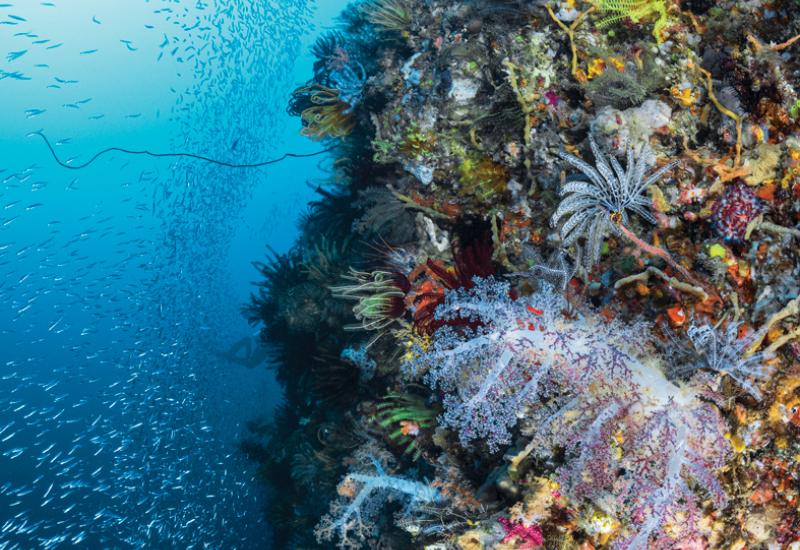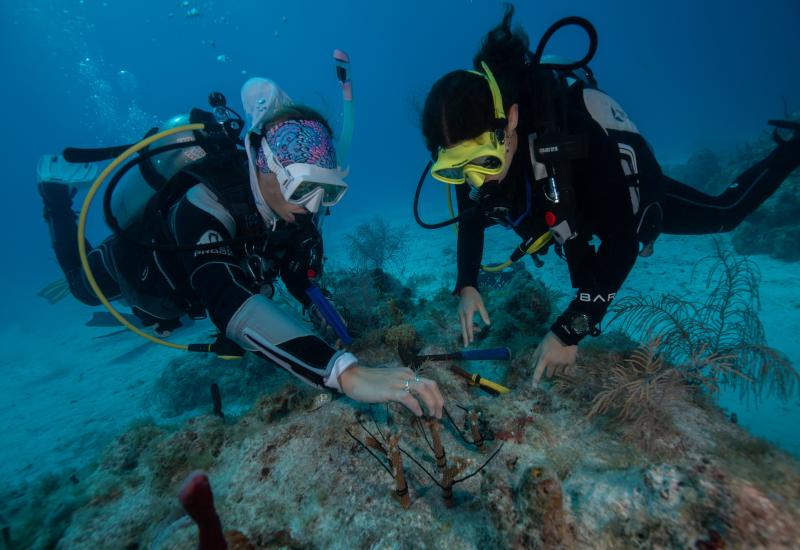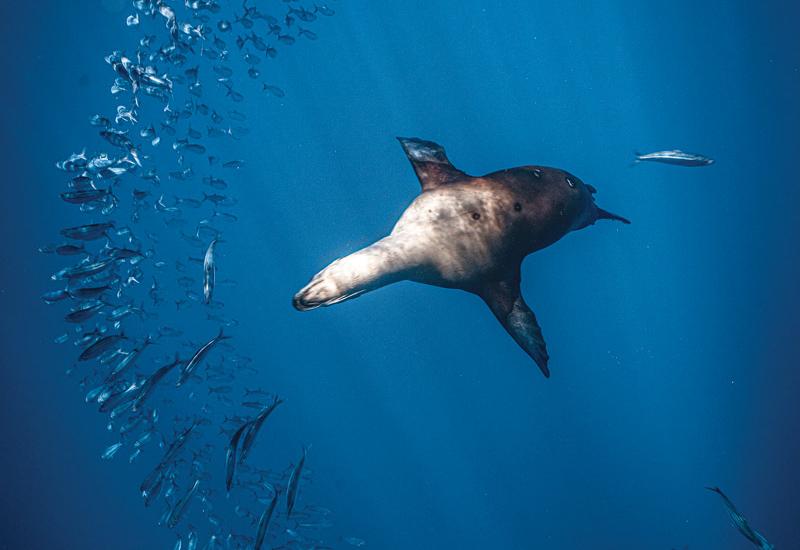The Manatees of Citrus County

December 2006
Text and photography by Scott Johnson
For centuries, weary sailors reported seeing mermaids off the bows of their ships. It's now believed that the seamen were most likely catching glimpses of manatees (or dugongs, their Pacific cousins). While it's easy to imagine why a manatee might be called cute, only a drunk or half-blind sailor could ever confuse one with a woman. If you don't believe me, pack your bags, hop in your car and drive to Citrus County, Fla., during manatee season to see for yourself.
My adventure began when I woke up one February morning at the Homosassa Riverside Resort to a mix of good and bad news. I listened to the Weather Channel for a last-minute update before heading to the dock. On the plus side, the air temp was warmer than expected (in the low 50s), which meant I didn't have to wear many layers of clothes. The potential bummer was that manatees are usually found in the greatest concentrations on the coldest mornings. A good rule of thumb is that if there is frost on the boat's windshield, the manatees will put on an incredible show.
My dive buddies and I loaded the boat and slowly made our way to Three Sisters, one of the top locations for photographing manatees. Dense fog had created a dreamlike setting. Just as we feared, we passed numerous manatees heading toward the Gulf and away from our destination. But to our pleasant surprise, Three Sisters was full of life.
We anchored a safe distance from the sanctuary and slipped into the bracing 72-degree water. I made my way to the edge of the sanctuary boundary. Within minutes, my arrival had caught the attention of one juvenile and two adult manatees--and the fun began. For the next four hours, I was nuzzled, poked, bumped and lightly chewed on--all in about six feet of water. I was fortunate that I didn't choke on gallons of river water during frequent outbursts of laughter.
Winter Sanctuary
According to the Florida Fish and Wildlife Commission's annual surveys, there are fewer than 3,000 manatees in Florida's waters. Despite a life expectancy of more than 55 years, and federal and state laws to ensure their survival, manatees continually ride the cusp of extinction. Females are not thought to be sexually mature until an average age of seven and then only produce one calf every two to five years. Manatees have no natural predators, but humans do pose a threat to the species. A boat's draft, propeller and most of all its captain can be lethal agents of death. I have yet to see a manatee that did not carry at least one boat-related scar. In addition, economic development has whittled away their habitats.
West Indian manatees are divided into two subspecies: the Florida manatee and the Antillean manatee. Found in and around Mexico, Central America, South America and the Greater Antilles, West Indian manatees, often called sea cows, feed on vegetation in fresh, salt and brackish water, from inland water systems to the open ocean. These gentle giants, which average 10 feet long and weigh over 1,000 pounds as adults, must eat between 10 and 15 percent of their body weight each day. Even with such robust figures, manatees actually have little body fat. Their susceptibility to cold stress syndrome when exposed to water temperatures of 68 degrees or less is what makes the warmer waters of Citrus County one of the best places in the world to swim with them.
Manatees typically begin to migrate to the Crystal and Homosassa river systems in late October, when the ocean's temperature drops into the 60s. Though the water temps of the river channels can also get chilly, the numerous springs, which bubble up through the subterranean limestone and feed the rivers, stay a constant 72 degrees. From the time the manatees reach their winter homes in late fall until they leave around Easter, they stay near the springs to rest, play and keep warm from dusk until late morning. Once the daily air temperatures begin to peak, manatees leave the comfort of the springs to seek vegetation to eat.
Three Sisters and King's Spring, located in the King's Bay area of the Crystal River, and the Homosassa Springs Wildlife State Park feature sanctuaries to ensure the manatees have protected places to rest in the warmth of the springs. In other words, no humans allowed inside the sanctuaries. However, the manatees still come close to visitors outside the designated sanctuaries in Three Sisters and King's Spring, making these locations ideal settings for encounters.
The day after our adventures at Three Sisters, we decided to dive at King's Spring. Manatees generally do not like the noise and bubbles of regulators, so snorkeling is the preferred method of encountering them. King's Spring, located at the south end of Banana Island, is the exception. Besides offering about the only decent opportunity to capture silhouettes of manatees as they move in and out of the area's large sanctuary, there is also an accessible cavern that can be explored from an opening at about 50 feet to its ceiling some 20 feet above.
Due to its size and the chance to observe other wildlife, the Homosassa Springs Wildlife State Park is my top choice for manatee encounters, even though visitors are permitted to observe the playful giants only from a floating observatory.
Spring Flings
A short drive north on Highway 41 will take you to two of the premier freshwater cavern dives in North America. The first, located in the town of Williston, is Devil's Den. Imaginative early settlers named the site after seeing steam rise from the cave's opening on cold winter mornings. The subterranean spring, located about 60 feet below the cave's opening, stays a constant 72 degrees and features several swim-throughs.
Another half hour or so drive north on Highway 41 takes you to world-famous Ginnie Springs. The spring water here can be breathtaking. Even Jacques Cousteau once marveled at its clarity by describing it as "visibility forever."
Ginnie Springs consists of two spring systems, Ginnie Spring and Devil Spring. Divers enter the namesake spring via a 100-foot wide, 15-foot deep, bowl-shaped basin. Like the accessible areas of Devil's Den, this underground cavern is deemed appropriate for all certified divers, even those lacking formal cave-diver training. Within the cavern is a semi-enclosed area called the Ballroom. Though sunlight decorates the surrounding water, dive lights are needed to examine the intricate formations, including fossils, etched in the limestone walls.
Devil Spring, which produces 80 million gallons of fresh water per day, includes three distinct dive sites: Devil's Eye, Devil's Ear and Little Devil. These sites are major attractions for certified cave divers. While there is plenty for novice divers to see here, divers lacking cave training are not allowed to use lights in the Devil Spring system, a measure to keep untrained divers from entering areas beyond their skill levels.
Guidelines for Manatee Encounters
Don't enter designated manatee sanctuaries, which are in effect from Nov. 15 through March 31.
When operating a boat, follow posted idle and slow speed zones. Wear polarized sunglasses, which reduce glare and help you see manatees more easily. Don't discard any litter (like fishing line) into the water. Keep your distance from any manatees you see, and avoid boating in areas where manatees feed and rest (like seagrass beds and springs).
When in the water, observe manatees from a distance, and only from the surface of the water. Never dive down under the water to observe manatees. And definitely never feed, poke, chase, ride or otherwise disturb manatees in any way. Manatees spend about eight hours a day eating, and more sleeping, so you can see that harassing them takes away from these vital activities.
Avoid splashing the water, which can startle manatees.
Never feed manatees or any wildlife.
InDepth
Crystal River and Homosassa River: Year-round water temperature in the rivers is 72 degrees, so a 5mm wetsuit is recommended. If you tend to get cold, bring a hood. Visibility varies depending on your location in the rivers, but can exceed 100 feet. Dive and Tour Operators: American Pro Diving, www.americanprodiving.com • Bird's Underwater, www.birdsunderwater.com • Crystal River Manatee Dive & Tour, www.manateetouranddive.com • Fun 2 Dive Scuba, www.fun2dive.com • Port Paradise Hotel & Marina, www.porthoteldivecenter.com • Sunshine River Tours, www.sunshinerivertours.com.
For More Info: www.savethemanatee.org and www.riversideresorts.com.
Ginnie Springs • Located in High Springs, 15 minutes west of Interstate 75. Open-water divers pay $27; certified cave divers, $20. Open daily. Camping available. Web: www.ginniespringsoutdoors.com.
Devil's Den • North of Williston, Fla., just off Rte. 27. General admission fee is $9. The diving fee is $31; dive fee and all rental gear, $67.41. Open daily. Camping available. Web: www.devilsden.com.
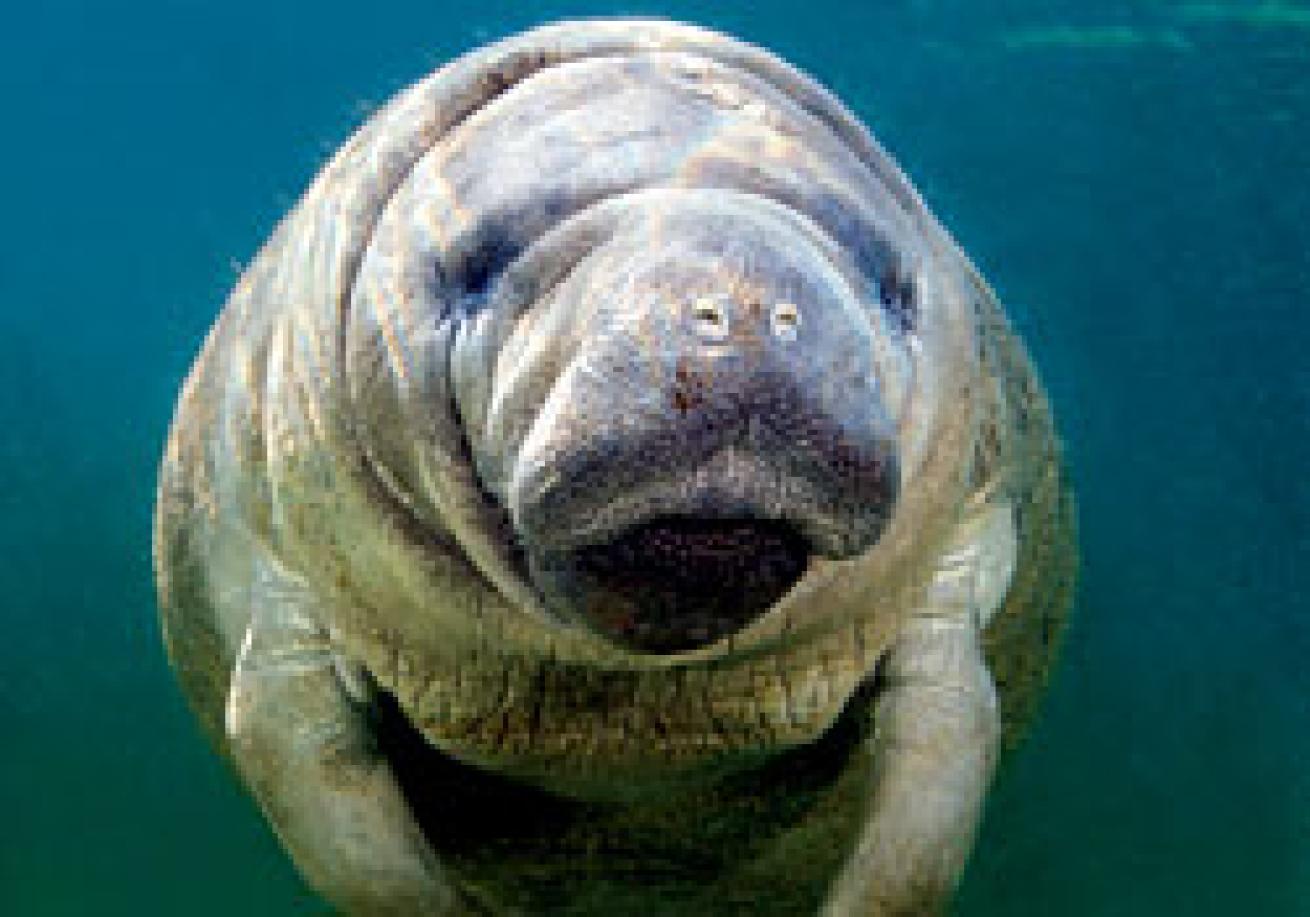
For centuries, weary sailors reported seeing mermaids off the bows of their ships. It's now believed that the seamen were most likely catching glimpses of manatees (or dugongs, their Pacific cousins). While it's easy to imagine why a manatee might be called cute, only a drunk or half-blind sailor could ever confuse one with a woman. If you don't believe me, pack your bags, hop in your car and drive to Citrus County, Fla., during manatee season to see for yourself.
My adventure began when I woke up one February morning at the Homosassa Riverside Resort to a mix of good and bad news. I listened to the Weather Channel for a last-minute update before heading to the dock. On the plus side, the air temp was warmer than expected (in the low 50s), which meant I didn't have to wear many layers of clothes. The potential bummer was that manatees are usually found in the greatest concentrations on the coldest mornings. A good rule of thumb is that if there is frost on the boat's windshield, the manatees will put on an incredible show.
My dive buddies and I loaded the boat and slowly made our way to Three Sisters, one of the top locations for photographing manatees. Dense fog had created a dreamlike setting. Just as we feared, we passed numerous manatees heading toward the Gulf and away from our destination. But to our pleasant surprise, Three Sisters was full of life.
We anchored a safe distance from the sanctuary and slipped into the bracing 72-degree water. I made my way to the edge of the sanctuary boundary. Within minutes, my arrival had caught the attention of one juvenile and two adult manatees--and the fun began. For the next four hours, I was nuzzled, poked, bumped and lightly chewed on--all in about six feet of water. I was fortunate that I didn't choke on gallons of river water during frequent outbursts of laughter.
Winter Sanctuary
According to the Florida Fish and Wildlife Commission's annual surveys, there are fewer than 3,000 manatees in Florida's waters. Despite a life expectancy of more than 55 years, and federal and state laws to ensure their survival, manatees continually ride the cusp of extinction. Females are not thought to be sexually mature until an average age of seven and then only produce one calf every two to five years. Manatees have no natural predators, but humans do pose a threat to the species. A boat's draft, propeller and most of all its captain can be lethal agents of death. I have yet to see a manatee that did not carry at least one boat-related scar. In addition, economic development has whittled away their habitats.
West Indian manatees are divided into two subspecies: the Florida manatee and the Antillean manatee. Found in and around Mexico, Central America, South America and the Greater Antilles, West Indian manatees, often called sea cows, feed on vegetation in fresh, salt and brackish water, from inland water systems to the open ocean. These gentle giants, which average 10 feet long and weigh over 1,000 pounds as adults, must eat between 10 and 15 percent of their body weight each day. Even with such robust figures, manatees actually have little body fat. Their susceptibility to cold stress syndrome when exposed to water temperatures of 68 degrees or less is what makes the warmer waters of Citrus County one of the best places in the world to swim with them.
Manatees typically begin to migrate to the Crystal and Homosassa river systems in late October, when the ocean's temperature drops into the 60s. Though the water temps of the river channels can also get chilly, the numerous springs, which bubble up through the subterranean limestone and feed the rivers, stay a constant 72 degrees. From the time the manatees reach their winter homes in late fall until they leave around Easter, they stay near the springs to rest, play and keep warm from dusk until late morning. Once the daily air temperatures begin to peak, manatees leave the comfort of the springs to seek vegetation to eat.
Three Sisters and King's Spring, located in the King's Bay area of the Crystal River, and the Homosassa Springs Wildlife State Park feature sanctuaries to ensure the manatees have protected places to rest in the warmth of the springs. In other words, no humans allowed inside the sanctuaries. However, the manatees still come close to visitors outside the designated sanctuaries in Three Sisters and King's Spring, making these locations ideal settings for encounters.
The day after our adventures at Three Sisters, we decided to dive at King's Spring. Manatees generally do not like the noise and bubbles of regulators, so snorkeling is the preferred method of encountering them. King's Spring, located at the south end of Banana Island, is the exception. Besides offering about the only decent opportunity to capture silhouettes of manatees as they move in and out of the area's large sanctuary, there is also an accessible cavern that can be explored from an opening at about 50 feet to its ceiling some 20 feet above.
Due to its size and the chance to observe other wildlife, the Homosassa Springs Wildlife State Park is my top choice for manatee encounters, even though visitors are permitted to observe the playful giants only from a floating observatory.
Spring Flings
A short drive north on Highway 41 will take you to two of the premier freshwater cavern dives in North America. The first, located in the town of Williston, is Devil's Den. Imaginative early settlers named the site after seeing steam rise from the cave's opening on cold winter mornings. The subterranean spring, located about 60 feet below the cave's opening, stays a constant 72 degrees and features several swim-throughs.
Another half hour or so drive north on Highway 41 takes you to world-famous Ginnie Springs. The spring water here can be breathtaking. Even Jacques Cousteau once marveled at its clarity by describing it as "visibility forever."
Ginnie Springs consists of two spring systems, Ginnie Spring and Devil Spring. Divers enter the namesake spring via a 100-foot wide, 15-foot deep, bowl-shaped basin. Like the accessible areas of Devil's Den, this underground cavern is deemed appropriate for all certified divers, even those lacking formal cave-diver training. Within the cavern is a semi-enclosed area called the Ballroom. Though sunlight decorates the surrounding water, dive lights are needed to examine the intricate formations, including fossils, etched in the limestone walls.
Devil Spring, which produces 80 million gallons of fresh water per day, includes three distinct dive sites: Devil's Eye, Devil's Ear and Little Devil. These sites are major attractions for certified cave divers. While there is plenty for novice divers to see here, divers lacking cave training are not allowed to use lights in the Devil Spring system, a measure to keep untrained divers from entering areas beyond their skill levels.
Guidelines for Manatee Encounters
Don't enter designated manatee sanctuaries, which are in effect from Nov. 15 through March 31.
When operating a boat, follow posted idle and slow speed zones. Wear polarized sunglasses, which reduce glare and help you see manatees more easily. Don't discard any litter (like fishing line) into the water. Keep your distance from any manatees you see, and avoid boating in areas where manatees feed and rest (like seagrass beds and springs).
When in the water, observe manatees from a distance, and only from the surface of the water. Never dive down under the water to observe manatees. And definitely never feed, poke, chase, ride or otherwise disturb manatees in any way. Manatees spend about eight hours a day eating, and more sleeping, so you can see that harassing them takes away from these vital activities.
Avoid splashing the water, which can startle manatees.
Never feed manatees or any wildlife.
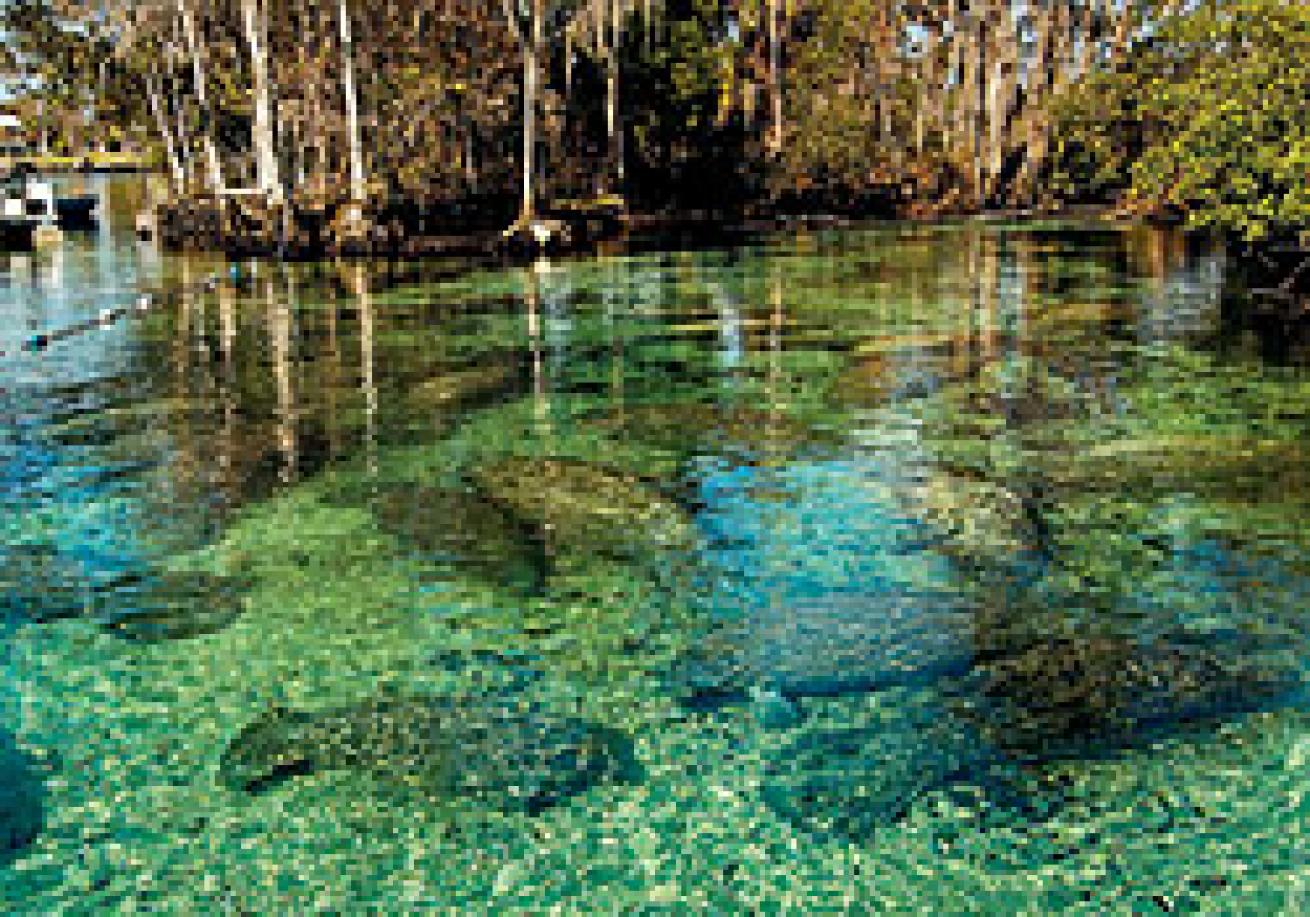
InDepth
Crystal River and Homosassa River: Year-round water temperature in the rivers is 72 degrees, so a 5mm wetsuit is recommended. If you tend to get cold, bring a hood. Visibility varies depending on your location in the rivers, but can exceed 100 feet. Dive and Tour Operators: American Pro Diving, www.americanprodiving.com • Bird's Underwater, www.birdsunderwater.com • Crystal River Manatee Dive & Tour, www.manateetouranddive.com • Fun 2 Dive Scuba, www.fun2dive.com • Port Paradise Hotel & Marina, www.porthoteldivecenter.com • Sunshine River Tours, www.sunshinerivertours.com.
For More Info: www.savethemanatee.org and www.riversideresorts.com.
Ginnie Springs • Located in High Springs, 15 minutes west of Interstate 75. Open-water divers pay $27; certified cave divers, $20. Open daily. Camping available. Web: www.ginniespringsoutdoors.com.
Devil's Den • North of Williston, Fla., just off Rte. 27. General admission fee is $9. The diving fee is $31; dive fee and all rental gear, $67.41. Open daily. Camping available. Web: www.devilsden.com.


